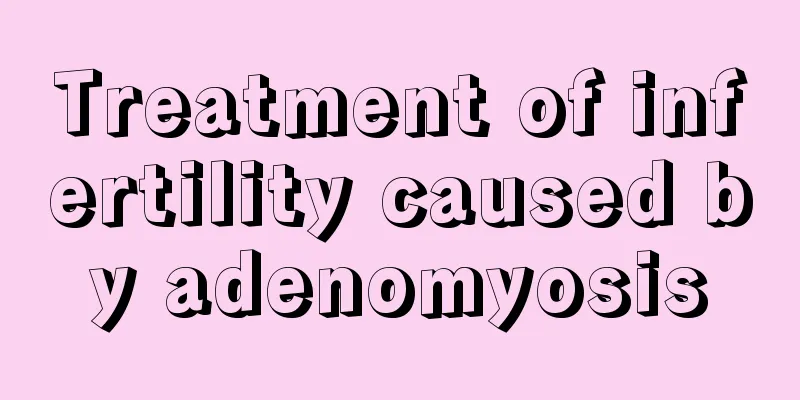Treatment of infertility caused by adenomyosis

|
I believe everyone is familiar with the symptoms of adenomyosis. Adenomyosis is a common symptom of ours. The occurrence of adenomyosis not only easily brings pain to female friends, but also brings great psychological pressure to female friends. In addition, adenomyosis can easily cause symptoms of infertility in female friends, so we must pay attention to this symptom. Below we introduce the treatment methods of infertility caused by adenomyosis. 1. Drug treatment Gonadotropin-releasing hormone agonist (GnRHa) is generally recognized as the drug of choice. The therapeutic mechanism of GnRHa for adenomyosis is still unclear. GnRH agonists can temporarily inhibit the hypothalamic-pituitary-gonad-ovarian axis, reduce estrogen levels in the body, cause atrophy of ectopic uterine lesions, reduce uterine size, and alleviate symptoms. Additionally, GnRHa may increase endometrial receptivity. A study on the relationship between the use of GnRHa in the treatment of adenomyosis and the pregnancy rate showed that there were 9 cases of natural pregnancies after medication, and all pregnancies occurred within 1 month to 12 months after the completion of treatment, indicating that the use of GnRHa can promote conception in patients with adenomyosis and decreased fertility. The authors also recommended that active assisted pregnancy should be used if pregnancy has not occurred within 6 months after completing drug treatment or after the first menstrual cycle after drug treatment. Domestic clinical observation data show that the pregnancy rate of GnRHa in treating patients with adenomyosis and infertility reached 75.0% (9/12). Khan KN et al. found that the number of endometrial macrophages was significantly reduced after GnRHa treatment in subfertile women with adenomyosis, thereby improving the success rate of embryo transfer. Data from Mijatovic et al. showed that the pregnancy rate of infertile patients with adenomyosis undergoing IVF or ICSI after GnRHa treatment was similar to that of infertile patients without adenomyosis. (ii) Conservative surgery Although there are case reports of pregnancy in patients with adenomyosis who underwent surgical treatment, the pregnancy rate of conservative surgery is lower than that of medical treatment. Possible reasons: (1) Due to the extensiveness of the lesion, the surgical resection rate is low; (2) It is difficult to avoid pelvic adhesions, uterine malformations, intrauterine adhesions, and reduced uterine volume after surgery, which may affect conception. (3) The surgical process inevitably causes endometriotic lesions to enter the myometrium, increasing the probability of endometrium entering the myometrium, with an incidence rate of 30%. (4) Compared with myomectomy, the blood supply around the uterine incision is poor, the tension of the uterine myometrium decreases, and the risk of postoperative uterine rupture may increase. A clinical observation showed that after conservative surgery for adenomyosis, 9 cases of natural pregnancy occurred, one of which had uterine rupture at 12 weeks of pregnancy. Pelvic denervation therapy: In recent years, foreign scholars have used open or laparoscopic presacral neurectomy (PSN) and uterine neurectomy (UNA) to treat primary and secondary dysmenorrhea, and achieved good results. Principle: The sensory nerve conduction pathway of the pelvic organs reaches the spine from the hypogastric plexus located in front of the sacrum, so cutting the presacral nerve trunk can block the pain conduction pathway. Both procedures cut most of the sensory nerve fibers to the cervix, thus relieving uterine pain. It is suitable for patients who are ineffective with drug treatment and wish to preserve their uterus, and can also improve the pregnancy rate. However, complications related to parasympathetic dysfunction may occur after surgery, such as diarrhea, constipation, urinary system symptoms, vaginal dryness, sexual discomfort or extreme excitement, etc. The above symptoms can be significantly improved after medication or without special treatment. Other extremely rare complications include: right iliac artery injury, chylous ascites and unilateral labia edema. In the above article, we introduced a common symptom, which is adenomyosis. We know that adenomyosis is very harmful, so we must pay attention to this symptom. The above article introduces in detail the treatment methods for infertility caused by adenomyosis. |
<<: Can adenomyosis cause miscarriage?
>>: What to do if there is a meat ball in the vagina
Recommend
IVF long protocol process steps
In the process of test tube fertilization, one of...
Shoulder-hand syndrome after cerebral infarction? Don’t be afraid, musculoskeletal ultrasound can help!
Author: Wang Xiaolei, Chief Physician, Affiliated...
Pain four fingers below the navel in women
In our daily life, we often suffer from stomach p...
What is the painless childbirth experience like?
Painless childbirth is the choice of many pregnan...
Accessory breasts are not your enemy, they are your friend!
This is the 3540th article of Da Yi Xiao Hu Many ...
Is it normal to not have withdrawal bleeding after taking birth control pills?
If a man and a woman are not sure they want to ha...
Will the cervix open if the labor pain is irregular?
We know that contractions are usually regular, us...
Hypoglycemia is really terrible, and it can be fatal if it is serious!!! Don’t take it lightly anymore!
On a working day that seemed no different from an...
What are the tips for removing melasma?
Chloasma is a problem for many women. There are m...
What should I do if my waist hurts so much after taking the first pill for medical abortion?
When it comes to abortion, what everyone thinks o...
Why does my breast hurt when I move it?
If your breasts hurt when you move them, you may ...
The due date is approaching and the fetus is moving frequently
When the due date arrives, it is actually very co...
Health products for women who stay up late
Modern women are under great pressure. Not only d...
Why do I have periods again a week after my period ends?
Women should pay attention to the observation of ...
What to do if you have vaginal bleeding during childbirth
Vaginal bleeding refers to bleeding from any part...









